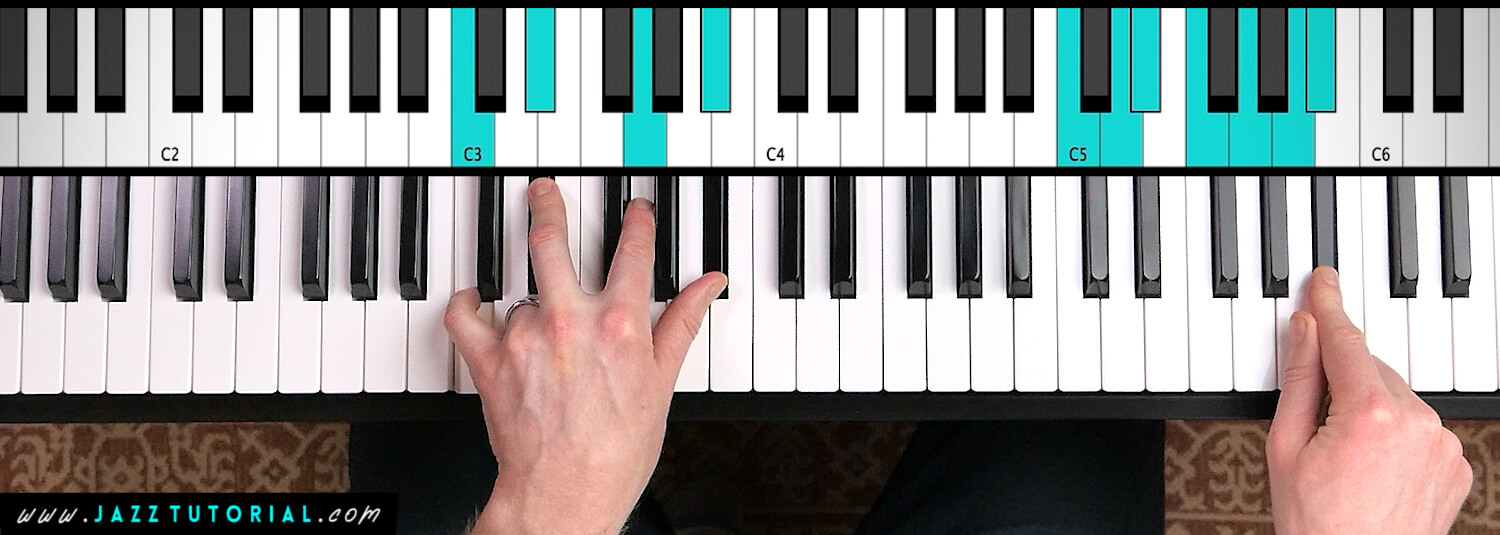The ‘So What’ Voicing by Bill Evans
The Miles Davis tune, ‘So What’, features two distinctive minor 7 chords played by Bill Evans:

Bill Evans uses the same chord voicing for both chords (since they're both a minor 7 chord), and he 'side-slips' (transposes) the voicing down a whole-step from E minor 7 to D minor 7.
In the jazz piano world, this voicing is known as 'the So What voicing’. Here’s how it looks built from C:
C minor 7 = C F Bb Eb G.
You can think of this voicing as a stack of 4ths built from the root going up to its 3rd (C - F - Bb - Eb), then add the chord's 5th on top (G).
This voicing is a good choice when you see a minor 7 chord in the chord sheet, and the melody note is the chord’s 5th.
FREE RESOURCE: For more jazz piano chord voicings, you can download my free ‘Jazz Piano Chord Voicing Guide' which shows you 5 types of chord voicing used by professionals (shells, 4th voicings, rootless voicings, and more): Click here to download
'So What' & the Dorian Scale
‘So What’ is written in the dorian scale (the song is in D dorian, which is D E F G A B C).
But first, let's take a look at C dorian scale (commonly played over C minor 7 chords):

C dorian scale = C D Eb F G A Bb
You can think of the dorian scale as a minor scale with a major 6th.
When playing in the dorian scale, you’re able to play two minor 7 chords next to each other, built from the scale's root and 2nd (C min 7 and D min 7) - this is only possible because the dorian scale has a major 6th (A), whereas it would not be possible in the natural minor scale which has a minor 6th (Ab).
This is exactly what Bill Evans plays - the ii chord resolving to the i chord (both minor 7 chords), except 'So What' is in D dorian which means he plays E min 7 - D min 7:

Notice also that the bass line plays notes from D dorian scale too: D A B C D E C D A.
Homework Challenge
First, play the ‘So What’ voicing from all twelve notes (C min 7 - C# min 7 - D min 7 - Eb min 7 - E min 7 - F min 7, etc). Challenge yourself to play all twelve chords note-perfectly in a row - if you make a mistake, you have to go back and start from zero!
Next, play through the songs in your real book and look for opportunities to use the ‘So What’ voicing (1 4 / 7 3 5 for minor 7 chords only). Look out for minor 7 chords which have the 5th in the melody.

RECOMMENDED SONGS: So What, Blue Bossa, Dolphin Dance, Summertime. Get my Real Books Guide (free).
Free Jazz Piano Resources
Get my free sheet music collection sent to your email inbox:
-
29 Jazz Piano Licks (sheet music)
-
The Jazz Piano Chord Voicing Guide (ebook)
-
Instagram Jazz Piano Riffs (sheet music + MIDI)
-
Jazz Chords Ultimate Guide
About the Author
Julian Bradley is a jazz pianist and music educator from the U.K. He has a masters degree in music from Bristol University, and has played with and composed for a variety of big bands.
Julian runs the popular Jazz Tutorial YouTube channel and writes educational jazz lessons at JazzTutorial.com
